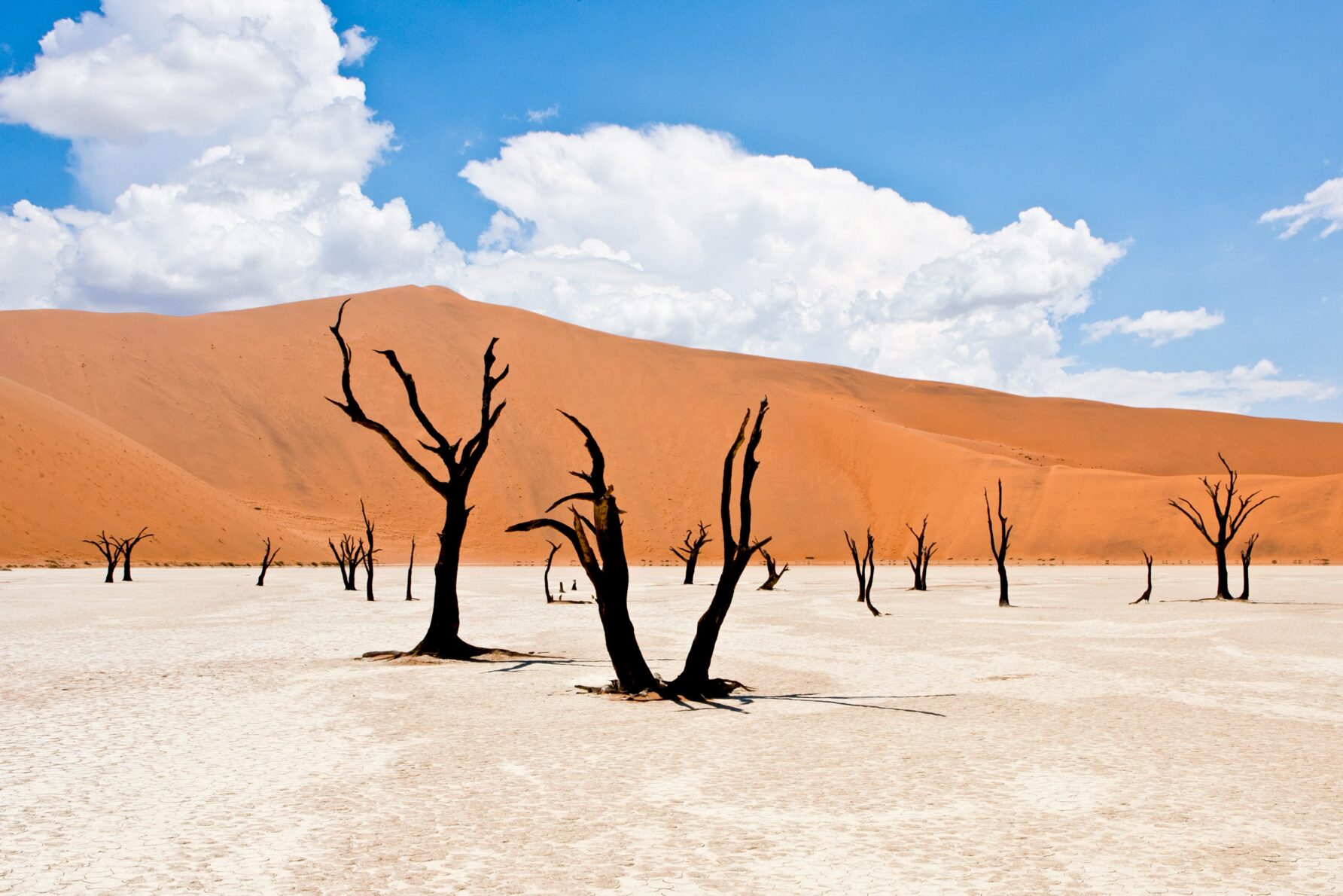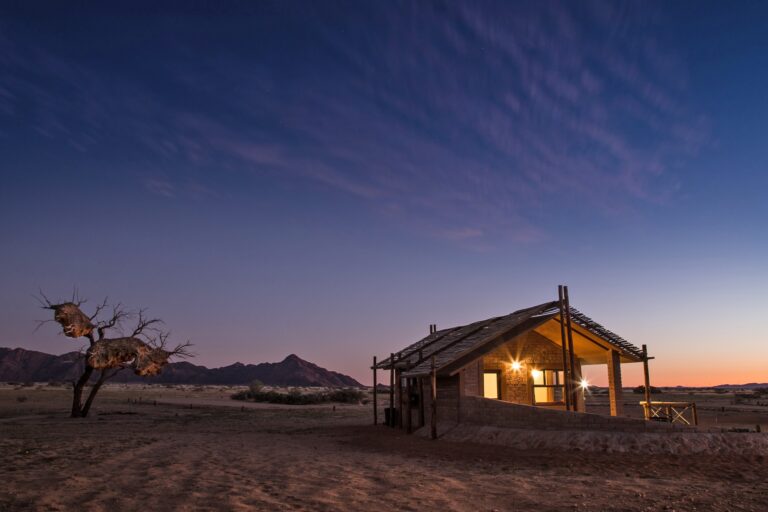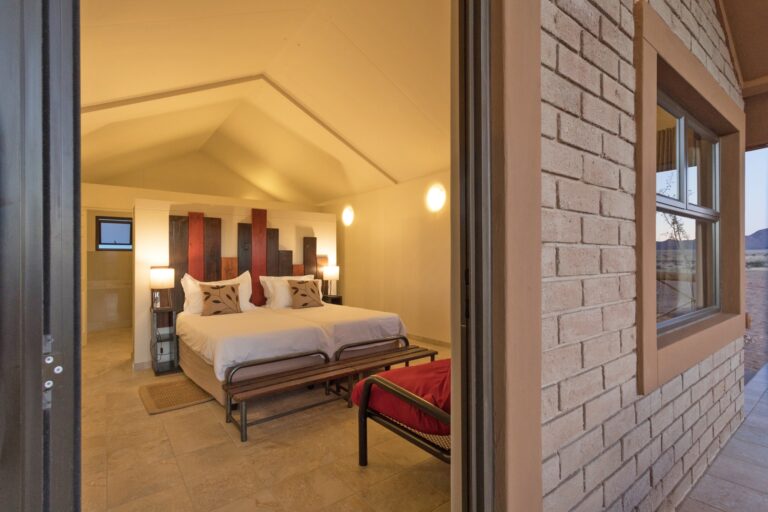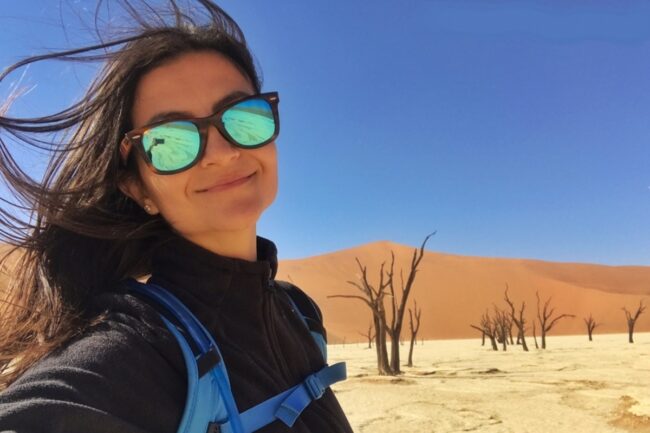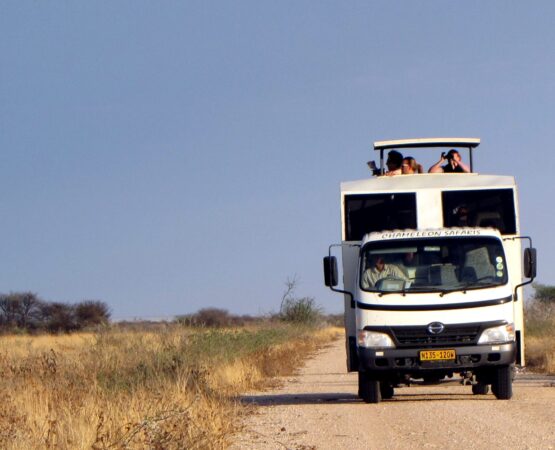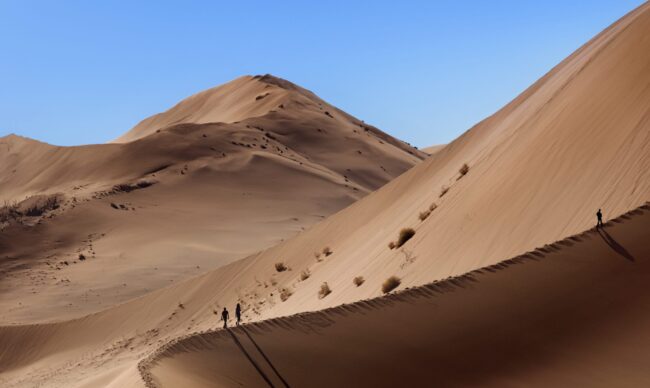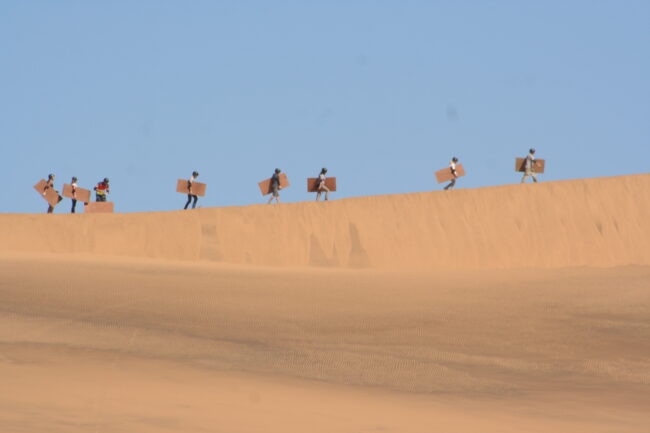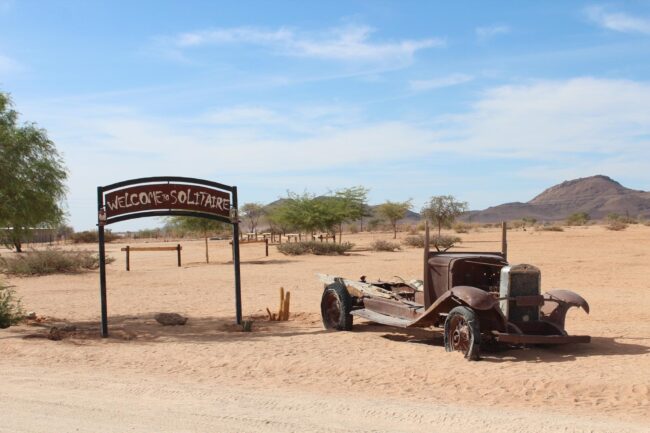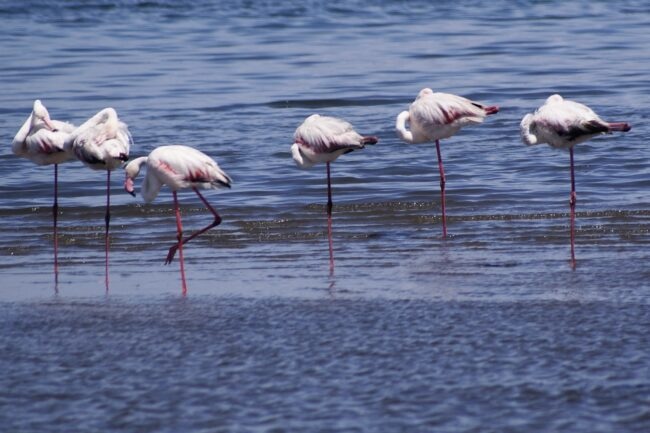|
Thursday
3 Apr 2025
Windhoek
Windhoek
|
Sunday
6 Apr 2025
Windhoek
|
|
ON
SALE
ZAR
0
ZAR
0
|
|
| Option |
Price Per Person |
Lodge - Twin Share
|
0
22,500
ZAR 22,500
Per Person
|
Lodge - Single
|
0
25,500
ZAR 25,500
Per Person
|
?Child rates apply to children aged 5 to 11 years of age and must share with two full paying adults, otherwise adult rate will apply. No children under the age of 5 years are allowed on this safari.
PRICE PER CHILD
|
0
20,000
ZAR 20,000
Per Child
|
|
|
Thursday
10 Apr 2025
Windhoek
Windhoek
|
Sunday
13 Apr 2025
Windhoek
|
|
ON
SALE
ZAR
0
ZAR
0
|
|
| Option |
Price Per Person |
Lodge - Twin Share
|
0
22,500
ZAR 22,500
Per Person
|
Lodge - Single
|
0
25,500
ZAR 25,500
Per Person
|
?Child rates apply to children aged 5 to 11 years of age and must share with two full paying adults, otherwise adult rate will apply. No children under the age of 5 years are allowed on this safari.
PRICE PER CHILD
|
0
20,000
ZAR 20,000
Per Child
|
|
|
Thursday
17 Apr 2025
Windhoek
Windhoek
|
Sunday
20 Apr 2025
Windhoek
|
|
ON
SALE
ZAR
0
ZAR
0
|
|
| Option |
Price Per Person |
Lodge - Twin Share
|
0
22,500
ZAR 22,500
Per Person
|
Lodge - Single
|
0
25,500
ZAR 25,500
Per Person
|
?Child rates apply to children aged 5 to 11 years of age and must share with two full paying adults, otherwise adult rate will apply. No children under the age of 5 years are allowed on this safari.
PRICE PER CHILD
|
0
20,000
ZAR 20,000
Per Child
|
|
|
Thursday
24 Apr 2025
Windhoek
Windhoek
|
Sunday
27 Apr 2025
Windhoek
|
|
ON
SALE
ZAR
0
ZAR
0
|
|
| Option |
Price Per Person |
Lodge - Twin Share
|
0
22,500
ZAR 22,500
Per Person
|
Lodge - Single
|
0
25,500
ZAR 25,500
Per Person
|
?Child rates apply to children aged 5 to 11 years of age and must share with two full paying adults, otherwise adult rate will apply. No children under the age of 5 years are allowed on this safari.
PRICE PER CHILD
|
0
20,000
ZAR 20,000
Per Child
|
|
|
Thursday
1 May 2025
Windhoek
Windhoek
|
Sunday
4 May 2025
Windhoek
|
|
ON
SALE
ZAR
0
ZAR
0
|
|
| Option |
Price Per Person |
Lodge - Twin Share
|
0
22,500
ZAR 22,500
Per Person
|
Lodge - Single
|
0
25,500
ZAR 25,500
Per Person
|
?Child rates apply to children aged 5 to 11 years of age and must share with two full paying adults, otherwise adult rate will apply. No children under the age of 5 years are allowed on this safari.
PRICE PER CHILD
|
0
20,000
ZAR 20,000
Per Child
|
|
|
Thursday
8 May 2025
Windhoek
Windhoek
|
Sunday
11 May 2025
Windhoek
|
|
ON
SALE
ZAR
0
ZAR
0
|
|
| Option |
Price Per Person |
Lodge - Twin Share
|
0
22,500
ZAR 22,500
Per Person
|
Lodge - Single
|
0
25,500
ZAR 25,500
Per Person
|
?Child rates apply to children aged 5 to 11 years of age and must share with two full paying adults, otherwise adult rate will apply. No children under the age of 5 years are allowed on this safari.
PRICE PER CHILD
|
0
20,000
ZAR 20,000
Per Child
|
|
|
Thursday
15 May 2025
Windhoek
Windhoek
|
Sunday
18 May 2025
Windhoek
|
|
ON
SALE
ZAR
0
ZAR
0
|
|
| Option |
Price Per Person |
Lodge - Twin Share
|
0
22,500
ZAR 22,500
Per Person
|
Lodge - Single
|
0
25,500
ZAR 25,500
Per Person
|
?Child rates apply to children aged 5 to 11 years of age and must share with two full paying adults, otherwise adult rate will apply. No children under the age of 5 years are allowed on this safari.
PRICE PER CHILD
|
0
20,000
ZAR 20,000
Per Child
|
|
|
Thursday
22 May 2025
Windhoek
Windhoek
|
Sunday
25 May 2025
Windhoek
|
|
ON
SALE
ZAR
0
ZAR
0
|
|
| Option |
Price Per Person |
Lodge - Twin Share
|
0
22,500
ZAR 22,500
Per Person
|
Lodge - Single
|
0
25,500
ZAR 25,500
Per Person
|
?Child rates apply to children aged 5 to 11 years of age and must share with two full paying adults, otherwise adult rate will apply. No children under the age of 5 years are allowed on this safari.
PRICE PER CHILD
|
0
20,000
ZAR 20,000
Per Child
|
|
|
Thursday
29 May 2025
Windhoek
Windhoek
|
Sunday
1 Jun 2025
Windhoek
|
|
ON
SALE
ZAR
0
ZAR
0
|
|
| Option |
Price Per Person |
Lodge - Twin Share
|
0
22,500
ZAR 22,500
Per Person
|
Lodge - Single
|
0
25,500
ZAR 25,500
Per Person
|
?Child rates apply to children aged 5 to 11 years of age and must share with two full paying adults, otherwise adult rate will apply. No children under the age of 5 years are allowed on this safari.
PRICE PER CHILD
|
0
20,000
ZAR 20,000
Per Child
|
|
|
Thursday
5 Jun 2025
Windhoek
Windhoek
|
Sunday
8 Jun 2025
Windhoek
|
|
ON
SALE
ZAR
0
ZAR
0
|
|
| Option |
Price Per Person |
Lodge - Twin Share
|
0
22,500
ZAR 22,500
Per Person
|
Lodge - Single
|
0
25,500
ZAR 25,500
Per Person
|
?Child rates apply to children aged 5 to 11 years of age and must share with two full paying adults, otherwise adult rate will apply. No children under the age of 5 years are allowed on this safari.
PRICE PER CHILD
|
0
20,000
ZAR 20,000
Per Child
|
|
|
Thursday
12 Jun 2025
Windhoek
Windhoek
|
Sunday
15 Jun 2025
Windhoek
|
|
ON
SALE
ZAR
0
ZAR
0
|
|
| Option |
Price Per Person |
Lodge - Twin Share
|
0
22,500
ZAR 22,500
Per Person
|
Lodge - Single
|
0
25,500
ZAR 25,500
Per Person
|
?Child rates apply to children aged 5 to 11 years of age and must share with two full paying adults, otherwise adult rate will apply. No children under the age of 5 years are allowed on this safari.
PRICE PER CHILD
|
0
20,000
ZAR 20,000
Per Child
|
|
|
Thursday
19 Jun 2025
Windhoek
Windhoek
|
Sunday
22 Jun 2025
Windhoek
|
|
ON
SALE
ZAR
0
ZAR
0
|
|
| Option |
Price Per Person |
Lodge - Twin Share
|
0
22,500
ZAR 22,500
Per Person
|
Lodge - Single
|
0
25,500
ZAR 25,500
Per Person
|
?Child rates apply to children aged 5 to 11 years of age and must share with two full paying adults, otherwise adult rate will apply. No children under the age of 5 years are allowed on this safari.
PRICE PER CHILD
|
0
20,000
ZAR 20,000
Per Child
|
|
|
Thursday
26 Jun 2025
Windhoek
Windhoek
|
Sunday
29 Jun 2025
Windhoek
|
|
ON
SALE
ZAR
0
ZAR
0
|
|
| Option |
Price Per Person |
Lodge - Twin Share
|
0
22,500
ZAR 22,500
Per Person
|
Lodge - Single
|
0
25,500
ZAR 25,500
Per Person
|
?Child rates apply to children aged 5 to 11 years of age and must share with two full paying adults, otherwise adult rate will apply. No children under the age of 5 years are allowed on this safari.
PRICE PER CHILD
|
0
20,000
ZAR 20,000
Per Child
|
|
|
Thursday
3 Jul 2025
Windhoek
Windhoek
|
Sunday
6 Jul 2025
Windhoek
|
|
ON
SALE
ZAR
0
ZAR
0
|
|
| Option |
Price Per Person |
Lodge - Twin Share
|
0
22,500
ZAR 22,500
Per Person
|
Lodge - Single
|
0
25,500
ZAR 25,500
Per Person
|
?Child rates apply to children aged 5 to 11 years of age and must share with two full paying adults, otherwise adult rate will apply. No children under the age of 5 years are allowed on this safari.
PRICE PER CHILD
|
0
20,000
ZAR 20,000
Per Child
|
|
|
Thursday
10 Jul 2025
Windhoek
Windhoek
|
Sunday
13 Jul 2025
Windhoek
|
|
ON
SALE
ZAR
0
ZAR
0
|
|
| Option |
Price Per Person |
Lodge - Twin Share
|
0
22,500
ZAR 22,500
Per Person
|
Lodge - Single
|
0
25,500
ZAR 25,500
Per Person
|
?Child rates apply to children aged 5 to 11 years of age and must share with two full paying adults, otherwise adult rate will apply. No children under the age of 5 years are allowed on this safari.
PRICE PER CHILD
|
0
20,000
ZAR 20,000
Per Child
|
|
|
Thursday
17 Jul 2025
Windhoek
Windhoek
|
Sunday
20 Jul 2025
Windhoek
|
|
ON
SALE
ZAR
0
ZAR
0
|
|
| Option |
Price Per Person |
Lodge - Twin Share
|
0
22,500
ZAR 22,500
Per Person
|
Lodge - Single
|
0
25,500
ZAR 25,500
Per Person
|
?Child rates apply to children aged 5 to 11 years of age and must share with two full paying adults, otherwise adult rate will apply. No children under the age of 5 years are allowed on this safari.
PRICE PER CHILD
|
0
20,000
ZAR 20,000
Per Child
|
|
|
Thursday
24 Jul 2025
Windhoek
Windhoek
|
Sunday
27 Jul 2025
Windhoek
|
|
ON
SALE
ZAR
0
ZAR
0
|
|
| Option |
Price Per Person |
Lodge - Twin Share
|
0
22,500
ZAR 22,500
Per Person
|
Lodge - Single
|
0
25,500
ZAR 25,500
Per Person
|
?Child rates apply to children aged 5 to 11 years of age and must share with two full paying adults, otherwise adult rate will apply. No children under the age of 5 years are allowed on this safari.
PRICE PER CHILD
|
0
20,000
ZAR 20,000
Per Child
|
|
|
Thursday
31 Jul 2025
Windhoek
Windhoek
|
Sunday
3 Aug 2025
Windhoek
|
|
ON
SALE
ZAR
0
ZAR
0
|
|
| Option |
Price Per Person |
Lodge - Twin Share
|
0
22,500
ZAR 22,500
Per Person
|
Lodge - Single
|
0
25,500
ZAR 25,500
Per Person
|
?Child rates apply to children aged 5 to 11 years of age and must share with two full paying adults, otherwise adult rate will apply. No children under the age of 5 years are allowed on this safari.
PRICE PER CHILD
|
0
20,000
ZAR 20,000
Per Child
|
|
|
Thursday
7 Aug 2025
Windhoek
Windhoek
|
Sunday
10 Aug 2025
Windhoek
|
|
ON
SALE
ZAR
0
ZAR
0
|
|
| Option |
Price Per Person |
Lodge - Twin Share
|
0
22,500
ZAR 22,500
Per Person
|
Lodge - Single
|
0
25,500
ZAR 25,500
Per Person
|
?Child rates apply to children aged 5 to 11 years of age and must share with two full paying adults, otherwise adult rate will apply. No children under the age of 5 years are allowed on this safari.
PRICE PER CHILD
|
0
20,000
ZAR 20,000
Per Child
|
|
|
Thursday
14 Aug 2025
Windhoek
Windhoek
|
Sunday
17 Aug 2025
Windhoek
|
|
ON
SALE
ZAR
0
ZAR
0
|
|
| Option |
Price Per Person |
Lodge - Twin Share
|
0
22,500
ZAR 22,500
Per Person
|
Lodge - Single
|
0
25,500
ZAR 25,500
Per Person
|
?Child rates apply to children aged 5 to 11 years of age and must share with two full paying adults, otherwise adult rate will apply. No children under the age of 5 years are allowed on this safari.
PRICE PER CHILD
|
0
20,000
ZAR 20,000
Per Child
|
|
|
Thursday
21 Aug 2025
Windhoek
Windhoek
|
Sunday
24 Aug 2025
Windhoek
|
|
ON
SALE
ZAR
0
ZAR
0
|
|
| Option |
Price Per Person |
Lodge - Twin Share
|
0
22,500
ZAR 22,500
Per Person
|
Lodge - Single
|
0
25,500
ZAR 25,500
Per Person
|
?Child rates apply to children aged 5 to 11 years of age and must share with two full paying adults, otherwise adult rate will apply. No children under the age of 5 years are allowed on this safari.
PRICE PER CHILD
|
0
20,000
ZAR 20,000
Per Child
|
|
|
Thursday
28 Aug 2025
Windhoek
Windhoek
|
Sunday
31 Aug 2025
Windhoek
|
|
ON
SALE
ZAR
0
ZAR
0
|
|
| Option |
Price Per Person |
Lodge - Twin Share
|
0
22,500
ZAR 22,500
Per Person
|
Lodge - Single
|
0
25,500
ZAR 25,500
Per Person
|
?Child rates apply to children aged 5 to 11 years of age and must share with two full paying adults, otherwise adult rate will apply. No children under the age of 5 years are allowed on this safari.
PRICE PER CHILD
|
0
20,000
ZAR 20,000
Per Child
|
|
|
Thursday
4 Sep 2025
Windhoek
Windhoek
|
Sunday
7 Sep 2025
Windhoek
|
|
ON
SALE
ZAR
0
ZAR
0
|
|
| Option |
Price Per Person |
Lodge - Twin Share
|
0
22,500
ZAR 22,500
Per Person
|
Lodge - Single
|
0
25,500
ZAR 25,500
Per Person
|
?Child rates apply to children aged 5 to 11 years of age and must share with two full paying adults, otherwise adult rate will apply. No children under the age of 5 years are allowed on this safari.
PRICE PER CHILD
|
0
20,000
ZAR 20,000
Per Child
|
|
|
Thursday
11 Sep 2025
Windhoek
Windhoek
|
Sunday
14 Sep 2025
Windhoek
|
|
ON
SALE
ZAR
0
ZAR
0
|
|
| Option |
Price Per Person |
Lodge - Twin Share
|
0
22,500
ZAR 22,500
Per Person
|
Lodge - Single
|
0
25,500
ZAR 25,500
Per Person
|
?Child rates apply to children aged 5 to 11 years of age and must share with two full paying adults, otherwise adult rate will apply. No children under the age of 5 years are allowed on this safari.
PRICE PER CHILD
|
0
20,000
ZAR 20,000
Per Child
|
|
|
Thursday
18 Sep 2025
Windhoek
Windhoek
|
Sunday
21 Sep 2025
Windhoek
|
|
ON
SALE
ZAR
0
ZAR
0
|
|
| Option |
Price Per Person |
Lodge - Twin Share
|
0
22,500
ZAR 22,500
Per Person
|
Lodge - Single
|
0
25,500
ZAR 25,500
Per Person
|
?Child rates apply to children aged 5 to 11 years of age and must share with two full paying adults, otherwise adult rate will apply. No children under the age of 5 years are allowed on this safari.
PRICE PER CHILD
|
0
20,000
ZAR 20,000
Per Child
|
|
|
Thursday
25 Sep 2025
Windhoek
Windhoek
|
Sunday
28 Sep 2025
Windhoek
|
|
ON
SALE
ZAR
0
ZAR
0
|
|
| Option |
Price Per Person |
Lodge - Twin Share
|
0
22,500
ZAR 22,500
Per Person
|
Lodge - Single
|
0
25,500
ZAR 25,500
Per Person
|
?Child rates apply to children aged 5 to 11 years of age and must share with two full paying adults, otherwise adult rate will apply. No children under the age of 5 years are allowed on this safari.
PRICE PER CHILD
|
0
20,000
ZAR 20,000
Per Child
|
|
|
Thursday
2 Oct 2025
Windhoek
Windhoek
|
Sunday
5 Oct 2025
Windhoek
|
|
ON
SALE
ZAR
0
ZAR
0
|
|
| Option |
Price Per Person |
Lodge - Twin Share
|
0
22,500
ZAR 22,500
Per Person
|
Lodge - Single
|
0
25,500
ZAR 25,500
Per Person
|
?Child rates apply to children aged 5 to 11 years of age and must share with two full paying adults, otherwise adult rate will apply. No children under the age of 5 years are allowed on this safari.
PRICE PER CHILD
|
0
20,000
ZAR 20,000
Per Child
|
|
|
Thursday
9 Oct 2025
Windhoek
Windhoek
|
Sunday
12 Oct 2025
Windhoek
|
|
ON
SALE
ZAR
0
ZAR
0
|
|
| Option |
Price Per Person |
Lodge - Twin Share
|
0
22,500
ZAR 22,500
Per Person
|
Lodge - Single
|
0
25,500
ZAR 25,500
Per Person
|
?Child rates apply to children aged 5 to 11 years of age and must share with two full paying adults, otherwise adult rate will apply. No children under the age of 5 years are allowed on this safari.
PRICE PER CHILD
|
0
20,000
ZAR 20,000
Per Child
|
|
|
Thursday
16 Oct 2025
Windhoek
Windhoek
|
Sunday
19 Oct 2025
Windhoek
|
|
ON
SALE
ZAR
0
ZAR
0
|
|
| Option |
Price Per Person |
Lodge - Twin Share
|
0
22,500
ZAR 22,500
Per Person
|
Lodge - Single
|
0
25,500
ZAR 25,500
Per Person
|
?Child rates apply to children aged 5 to 11 years of age and must share with two full paying adults, otherwise adult rate will apply. No children under the age of 5 years are allowed on this safari.
PRICE PER CHILD
|
0
20,000
ZAR 20,000
Per Child
|
|
|
Thursday
23 Oct 2025
Windhoek
Windhoek
|
Sunday
26 Oct 2025
Windhoek
|
|
ON
SALE
ZAR
0
ZAR
0
|
|
| Option |
Price Per Person |
Lodge - Twin Share
|
0
22,500
ZAR 22,500
Per Person
|
Lodge - Single
|
0
25,500
ZAR 25,500
Per Person
|
?Child rates apply to children aged 5 to 11 years of age and must share with two full paying adults, otherwise adult rate will apply. No children under the age of 5 years are allowed on this safari.
PRICE PER CHILD
|
0
20,000
ZAR 20,000
Per Child
|
|
|
Thursday
30 Oct 2025
Windhoek
Windhoek
|
Sunday
2 Nov 2025
Windhoek
|
|
ON
SALE
ZAR
0
ZAR
0
|
|
| Option |
Price Per Person |
Lodge - Twin Share
|
0
22,500
ZAR 22,500
Per Person
|
Lodge - Single
|
0
25,500
ZAR 25,500
Per Person
|
?Child rates apply to children aged 5 to 11 years of age and must share with two full paying adults, otherwise adult rate will apply. No children under the age of 5 years are allowed on this safari.
PRICE PER CHILD
|
0
20,000
ZAR 20,000
Per Child
|
|
|
Thursday
6 Nov 2025
Windhoek
Windhoek
|
Sunday
9 Nov 2025
Windhoek
|
|
ON
SALE
ZAR
0
ZAR
0
|
|
| Option |
Price Per Person |
Lodge - Twin Share
|
0
22,500
ZAR 22,500
Per Person
|
Lodge - Single
|
0
25,500
ZAR 25,500
Per Person
|
?Child rates apply to children aged 5 to 11 years of age and must share with two full paying adults, otherwise adult rate will apply. No children under the age of 5 years are allowed on this safari.
PRICE PER CHILD
|
0
20,000
ZAR 20,000
Per Child
|
|
|
Thursday
13 Nov 2025
Windhoek
Windhoek
|
Sunday
16 Nov 2025
Windhoek
|
|
ON
SALE
ZAR
0
ZAR
0
|
|
| Option |
Price Per Person |
Lodge - Twin Share
|
0
22,500
ZAR 22,500
Per Person
|
Lodge - Single
|
0
25,500
ZAR 25,500
Per Person
|
?Child rates apply to children aged 5 to 11 years of age and must share with two full paying adults, otherwise adult rate will apply. No children under the age of 5 years are allowed on this safari.
PRICE PER CHILD
|
0
20,000
ZAR 20,000
Per Child
|
|
|
Thursday
20 Nov 2025
Windhoek
Windhoek
|
Sunday
23 Nov 2025
Windhoek
|
|
ON
SALE
ZAR
0
ZAR
0
|
|
| Option |
Price Per Person |
Lodge - Twin Share
|
0
22,500
ZAR 22,500
Per Person
|
Lodge - Single
|
0
25,500
ZAR 25,500
Per Person
|
?Child rates apply to children aged 5 to 11 years of age and must share with two full paying adults, otherwise adult rate will apply. No children under the age of 5 years are allowed on this safari.
PRICE PER CHILD
|
0
20,000
ZAR 20,000
Per Child
|
|
|
Thursday
27 Nov 2025
Windhoek
Windhoek
|
Sunday
30 Nov 2025
Windhoek
|
|
ON
SALE
ZAR
0
ZAR
0
|
|
| Option |
Price Per Person |
Lodge - Twin Share
|
0
22,500
ZAR 22,500
Per Person
|
Lodge - Single
|
0
25,500
ZAR 25,500
Per Person
|
?Child rates apply to children aged 5 to 11 years of age and must share with two full paying adults, otherwise adult rate will apply. No children under the age of 5 years are allowed on this safari.
PRICE PER CHILD
|
0
20,000
ZAR 20,000
Per Child
|
|
|
Thursday
4 Dec 2025
Windhoek
Windhoek
|
Sunday
7 Dec 2025
Windhoek
|
|
ON
SALE
ZAR
0
ZAR
0
|
|
| Option |
Price Per Person |
Lodge - Twin Share
|
0
22,500
ZAR 22,500
Per Person
|
Lodge - Single
|
0
25,500
ZAR 25,500
Per Person
|
?Child rates apply to children aged 5 to 11 years of age and must share with two full paying adults, otherwise adult rate will apply. No children under the age of 5 years are allowed on this safari.
PRICE PER CHILD
|
0
20,000
ZAR 20,000
Per Child
|
|
|
Thursday
11 Dec 2025
Windhoek
Windhoek
|
Sunday
14 Dec 2025
Windhoek
|
|
ON
SALE
ZAR
0
ZAR
0
|
|
| Option |
Price Per Person |
Lodge - Twin Share
|
0
22,500
ZAR 22,500
Per Person
|
Lodge - Single
|
0
25,500
ZAR 25,500
Per Person
|
?Child rates apply to children aged 5 to 11 years of age and must share with two full paying adults, otherwise adult rate will apply. No children under the age of 5 years are allowed on this safari.
PRICE PER CHILD
|
0
20,000
ZAR 20,000
Per Child
|
|
|
Thursday
18 Dec 2025
Windhoek
Windhoek
|
Sunday
21 Dec 2025
Windhoek
|
|
ON
SALE
ZAR
0
ZAR
0
|
|
| Option |
Price Per Person |
Lodge - Twin Share
|
0
22,500
ZAR 22,500
Per Person
|
Lodge - Single
|
0
25,500
ZAR 25,500
Per Person
|
?Child rates apply to children aged 5 to 11 years of age and must share with two full paying adults, otherwise adult rate will apply. No children under the age of 5 years are allowed on this safari.
PRICE PER CHILD
|
0
20,000
ZAR 20,000
Per Child
|
|
|
Thursday
25 Dec 2025
Windhoek
Windhoek
|
Sunday
28 Dec 2025
Windhoek
|
|
ON
SALE
ZAR
0
ZAR
0
|
|
| Option |
Price Per Person |
Lodge - Twin Share
|
0
22,500
ZAR 22,500
Per Person
|
Lodge - Single
|
0
25,500
ZAR 25,500
Per Person
|
?Child rates apply to children aged 5 to 11 years of age and must share with two full paying adults, otherwise adult rate will apply. No children under the age of 5 years are allowed on this safari.
PRICE PER CHILD
|
0
20,000
ZAR 20,000
Per Child
|
|
|
Thursday
1 Jan 2026
Windhoek
Windhoek
|
Sunday
4 Jan 2026
Windhoek
|
|
ON
SALE
ZAR
0
ZAR
0
|
|
| Option |
Price Per Person |
Lodge - Twin Share
|
0
22,500
ZAR 22,500
Per Person
|
Lodge - Single
|
0
25,500
ZAR 25,500
Per Person
|
?Child rates apply to children aged 5 to 11 years of age and must share with two full paying adults, otherwise adult rate will apply. No children under the age of 5 years are allowed on this safari.
PRICE PER CHILD
|
0
20,000
ZAR 20,000
Per Child
|
|
|
Thursday
8 Jan 2026
Windhoek
Windhoek
|
Sunday
11 Jan 2026
Windhoek
|
|
ON
SALE
ZAR
0
ZAR
0
|
|
| Option |
Price Per Person |
Lodge - Twin Share
|
0
22,500
ZAR 22,500
Per Person
|
Lodge - Single
|
0
25,500
ZAR 25,500
Per Person
|
?Child rates apply to children aged 5 to 11 years of age and must share with two full paying adults, otherwise adult rate will apply. No children under the age of 5 years are allowed on this safari.
PRICE PER CHILD
|
0
20,000
ZAR 20,000
Per Child
|
|
|
Thursday
15 Jan 2026
Windhoek
Windhoek
|
Sunday
18 Jan 2026
Windhoek
|
|
ON
SALE
ZAR
0
ZAR
0
|
|
| Option |
Price Per Person |
Lodge - Twin Share
|
0
22,500
ZAR 22,500
Per Person
|
Lodge - Single
|
0
25,500
ZAR 25,500
Per Person
|
?Child rates apply to children aged 5 to 11 years of age and must share with two full paying adults, otherwise adult rate will apply. No children under the age of 5 years are allowed on this safari.
PRICE PER CHILD
|
0
20,000
ZAR 20,000
Per Child
|
|
|
Thursday
22 Jan 2026
Windhoek
Windhoek
|
Sunday
25 Jan 2026
Windhoek
|
|
ON
SALE
ZAR
0
ZAR
0
|
|
| Option |
Price Per Person |
Lodge - Twin Share
|
0
22,500
ZAR 22,500
Per Person
|
Lodge - Single
|
0
25,500
ZAR 25,500
Per Person
|
?Child rates apply to children aged 5 to 11 years of age and must share with two full paying adults, otherwise adult rate will apply. No children under the age of 5 years are allowed on this safari.
PRICE PER CHILD
|
0
20,000
ZAR 20,000
Per Child
|
|
|
Thursday
29 Jan 2026
Windhoek
Windhoek
|
Sunday
1 Feb 2026
Windhoek
|
|
ON
SALE
ZAR
0
ZAR
0
|
|
| Option |
Price Per Person |
Lodge - Twin Share
|
0
22,500
ZAR 22,500
Per Person
|
Lodge - Single
|
0
25,500
ZAR 25,500
Per Person
|
?Child rates apply to children aged 5 to 11 years of age and must share with two full paying adults, otherwise adult rate will apply. No children under the age of 5 years are allowed on this safari.
PRICE PER CHILD
|
0
20,000
ZAR 20,000
Per Child
|
|
|
Thursday
5 Feb 2026
Windhoek
Windhoek
|
Sunday
8 Feb 2026
Windhoek
|
|
ON
SALE
ZAR
0
ZAR
0
|
|
| Option |
Price Per Person |
Lodge - Twin Share
|
0
22,500
ZAR 22,500
Per Person
|
Lodge - Single
|
0
25,500
ZAR 25,500
Per Person
|
?Child rates apply to children aged 5 to 11 years of age and must share with two full paying adults, otherwise adult rate will apply. No children under the age of 5 years are allowed on this safari.
PRICE PER CHILD
|
0
20,000
ZAR 20,000
Per Child
|
|
|
Thursday
12 Feb 2026
Windhoek
Windhoek
|
Sunday
15 Feb 2026
Windhoek
|
|
ON
SALE
ZAR
0
ZAR
0
|
|
| Option |
Price Per Person |
Lodge - Twin Share
|
0
22,500
ZAR 22,500
Per Person
|
Lodge - Single
|
0
25,500
ZAR 25,500
Per Person
|
?Child rates apply to children aged 5 to 11 years of age and must share with two full paying adults, otherwise adult rate will apply. No children under the age of 5 years are allowed on this safari.
PRICE PER CHILD
|
0
20,000
ZAR 20,000
Per Child
|
|
|
Thursday
19 Feb 2026
Windhoek
Windhoek
|
Sunday
22 Feb 2026
Windhoek
|
|
ON
SALE
ZAR
0
ZAR
0
|
|
| Option |
Price Per Person |
Lodge - Twin Share
|
0
22,500
ZAR 22,500
Per Person
|
Lodge - Single
|
0
25,500
ZAR 25,500
Per Person
|
?Child rates apply to children aged 5 to 11 years of age and must share with two full paying adults, otherwise adult rate will apply. No children under the age of 5 years are allowed on this safari.
PRICE PER CHILD
|
0
20,000
ZAR 20,000
Per Child
|
|
|
Thursday
26 Feb 2026
Windhoek
Windhoek
|
Sunday
1 Mar 2026
Windhoek
|
|
ON
SALE
ZAR
0
ZAR
0
|
|
| Option |
Price Per Person |
Lodge - Twin Share
|
0
22,500
ZAR 22,500
Per Person
|
Lodge - Single
|
0
25,500
ZAR 25,500
Per Person
|
?Child rates apply to children aged 5 to 11 years of age and must share with two full paying adults, otherwise adult rate will apply. No children under the age of 5 years are allowed on this safari.
PRICE PER CHILD
|
0
20,000
ZAR 20,000
Per Child
|
|
|
Thursday
5 Mar 2026
Windhoek
Windhoek
|
Sunday
8 Mar 2026
Windhoek
|
|
ON
SALE
ZAR
0
ZAR
0
|
|
| Option |
Price Per Person |
Lodge - Twin Share
|
0
22,500
ZAR 22,500
Per Person
|
Lodge - Single
|
0
25,500
ZAR 25,500
Per Person
|
?Child rates apply to children aged 5 to 11 years of age and must share with two full paying adults, otherwise adult rate will apply. No children under the age of 5 years are allowed on this safari.
PRICE PER CHILD
|
0
20,000
ZAR 20,000
Per Child
|
|
|
Thursday
12 Mar 2026
Windhoek
Windhoek
|
Sunday
15 Mar 2026
Windhoek
|
|
ON
SALE
ZAR
0
ZAR
0
|
|
| Option |
Price Per Person |
Lodge - Twin Share
|
0
22,500
ZAR 22,500
Per Person
|
Lodge - Single
|
0
25,500
ZAR 25,500
Per Person
|
?Child rates apply to children aged 5 to 11 years of age and must share with two full paying adults, otherwise adult rate will apply. No children under the age of 5 years are allowed on this safari.
PRICE PER CHILD
|
0
20,000
ZAR 20,000
Per Child
|
|
|
Thursday
19 Mar 2026
Windhoek
Windhoek
|
Sunday
22 Mar 2026
Windhoek
|
|
ON
SALE
ZAR
0
ZAR
0
|
|
| Option |
Price Per Person |
Lodge - Twin Share
|
0
22,500
ZAR 22,500
Per Person
|
Lodge - Single
|
0
25,500
ZAR 25,500
Per Person
|
?Child rates apply to children aged 5 to 11 years of age and must share with two full paying adults, otherwise adult rate will apply. No children under the age of 5 years are allowed on this safari.
PRICE PER CHILD
|
0
20,000
ZAR 20,000
Per Child
|
|
|
Thursday
26 Mar 2026
Windhoek
Windhoek
|
Sunday
29 Mar 2026
Windhoek
|
|
ON
SALE
ZAR
0
ZAR
0
|
|
| Option |
Price Per Person |
Lodge - Twin Share
|
0
22,500
ZAR 22,500
Per Person
|
Lodge - Single
|
0
25,500
ZAR 25,500
Per Person
|
?Child rates apply to children aged 5 to 11 years of age and must share with two full paying adults, otherwise adult rate will apply. No children under the age of 5 years are allowed on this safari.
PRICE PER CHILD
|
0
20,000
ZAR 20,000
Per Child
|
|

